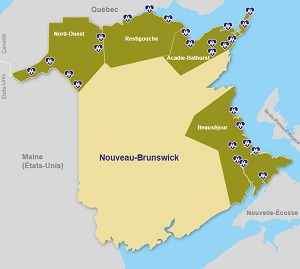Highlights of the Board of Directors public meeting
Campbellton, February 24, 2015 – The Board of Directors of Vitalité Health Network held its regular public meeting on Tuesday, February 24, 2015 in Campbellton.
The Network’s performance
Quality of care and client satisfaction
The Network obtained good results for indicators related the C. difficile infection rate, the short-term hospitalization rate related to ambulatory care sensitive conditions, and the medication error rate. Results also show a C-section rate of 31.4%, which is an increase over last year’s rate of 28.9%.
Financial elements
As at January 31, 2015, the Network had recorded total expenditures of $544.5 million, which translates into an operating surplus of $10.4 million, a reduction of 2.1% compared to the planned budget for this year. This surplus is primarily due to reductions of $5.7 million (1.6%) in salary and benefit expenditures and $1.6 million (5.1%) in medical and surgical supply expenditures compared to the planned budget.
The Network is also reporting deficits in some sectors, namely medication expenditures with a deficit of $300,000 (1.2%), energy expenditures with a deficit of $420,000 (3.4%), and equipment maintenance expenditures with a deficit of $290,000 (4.5%).
Operational and human resources factors
In terms of sick leave hours compared to the number of hours worked, the Network is reporting a rate of 5.8%, which is an improvement of 0.1% compared to the previous year and within this year’s target of 6.0%. In terms of overtime hours, our rate of 2.25% compared to the number of hours worked is just above our target of 2.12%. Our bed occupancy rate is 94.1%, which is slightly lower than our target of 95.0%.
Surveys on the patient experience
President and Chief Executive Officer Jean Castonguay outlined the key results of a second outpatient survey conducted in November 2014. Just over 5,000 patients completed the survey, i.e. a participation rate of 62%. Results show an overall satisfaction rate of 80%. Some of the surveyed elements included politeness and compassion of staff (89% satisfaction), time spent in waiting rooms (57% satisfaction), information received on what to do after appointments (74% satisfaction), and hand washing by staff before procedures (71% satisfaction).
The Network also presented the highlights of its inpatient satisfaction survey for January 2015. Results show an overall satisfaction rate of 66%, which is a drop of 14 percentage points compared to the same period the previous year. According to the President and Chief Executive Officer, the quality of care and services is a priority for the Network. “This is why we have implemented mechanisms to obtain feedback from our patients on an ongoing basis. It makes it possible for us to identify areas that require attention and to take the necessary action to constantly improve the services we offer.”
Strategic planning
Regional Health and Business Plan 2015-2018
The President and Chief Executive Officer indicated that the Regional Health and Business Plan 2015-2018 had been submitted to the Network Board of Directors. “This plan includes our organization’s broad strategic directions and objectives. A set of initiatives was developed for each of the objectives to ensure their implementation,” said Castonguay. Strategic planning for the deployment of clinical services to the points of service of the Network is ongoing. The purpose of these efforts is to ensure appropriate access to quality services using the financial, human and physical resources available. “The Regional Health and Business Plan, which is a requirement under the Regional Health Authorities Act, sets priority initiatives and objectives that will make it possible to deliver health care services that meet the health needs of the population.”
The Network’s Regional Health and Business Plan 2015-2018 must then be approved by the Minister of Health.
Collaborative work with all partners
The Network indicated that as part of its annual planning process, collaborative work with all health system partners and communities served was ongoing. “The Clinical Services Advisory Committee and Regional Primary Health Care Committee have accomplished a lot of work to advise management on broad strategic directions for care and services.”
The President and Chief Executive Officer also reported that the Network was participating actively in discussions as part of the Government’s strategic program review. “We are at the table with our partners to review the delivery of care provided to the population in New Brunswick and share our vision.” The President and Chief Executive Officer also reported that a number of meetings had recently been held with municipality and community group representatives. “I can understand the concerns generated by the strategic program review. This is why we are willing to meet with our community partners to hear what they have to say, share our directions with them, and answer their questions.”
The Government recently announced its intention to centralize common services for all departments and agencies. The scope of this project includes four sectors, namely (1) Human Resources, (2) Finance, (3) Information Technology, and (4) Supply Chain. “In our case, contrary to all departments and other agencies, Information Technology and Supply Chain have already been consolidated through FacilicorpNB. With respect to the Network, we can expect the Human Resources and Finance sectors to be impacted,” said Castonguay.
New food policy
The Board of Directors approved a new healthy food environments policy. This policy is part of the Network’s mission to promote wellness among employees, patients, and visitors. It will involve regular patient and cafeteria menus, as well as vending machines and snack bar services in its facilities. Action plans will be implemented to gradually increase the provision of foods with maximum nutritional value.

